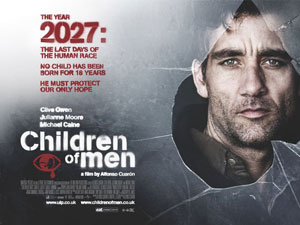 In the remaining weeks of 2006, American audiences are going to be treated to a succession of films that are stunning achievements, absolute masterworks. Any year end top ten list that doesn’t have one of these three movies in the top spot will be, to me, highly suspect. To have one of these films come out this year would make 2006 a banner year for the movies – for all three to hit makes it a year of almost supernatural quality. What’s funny (by which I mean what is tragically heartbreaking) is that it’s quite unlikely that any of these films will be major awards contenders at the end of the year, being usurped by blander, safer, less interesting movies.
In the remaining weeks of 2006, American audiences are going to be treated to a succession of films that are stunning achievements, absolute masterworks. Any year end top ten list that doesn’t have one of these three movies in the top spot will be, to me, highly suspect. To have one of these films come out this year would make 2006 a banner year for the movies – for all three to hit makes it a year of almost supernatural quality. What’s funny (by which I mean what is tragically heartbreaking) is that it’s quite unlikely that any of these films will be major awards contenders at the end of the year, being usurped by blander, safer, less interesting movies.
The first half of 2006 was not exactly a wasteland, but it was close. There were some very interesting movies that I liked quite a bit, and there were some flawed movies with absolutely wonderful elements, but nothing that stood out as the defining movie of the year. Some of my favorite films of the year – movies like Slither – came out in those first six months, but that familiar weariness set in as summer came. Sure, I really enjoyed Pirates 2, but something better had to come along.
And it did. I saw The Fountain at the beginning of the summer and I knew that I had found my number one movie of the year. It’s sort of bold to make that kind of claim so early on, but Darren Aronofsky’s film hit me in all the right places, emotionally, artistically and spiritually. The Fountain wasn’t made for me, but it feels like it could have been. Regardless, the movie is a masterpiece, a film that will live for decades in the minds of anyone who sees it.
The next of 2006’s masterpieces was Guillermo del Toro’s Pan’s Labyrinth. The movie is like a summation of everything Guillermo has done to date, and it’s also his formal coming out party – ‘I’m an honest to God genius,’ he’s telling us. The movie is wonderful from beginning to end, and it’s also the zenith of filmmaking as craft. Every element of the film is lovingly and carefully created, everything carrying a meaning and a weight. Del Toro also understands storytelling in a way that few of his peers can even imagine, and Pan’s Labyrinth is a film that works on so many levels – literal, metaphorical, psychologically – that it’s a joy to revisit again and again.
Tonight I saw 2006’s third honest to God masterpiece, and that’s Alfonso Cuaron’s Children of Men. I can’t review the film yet, and I wouldn’t want to since I haven’t had time to fully digest it (and it’s so goddamned dense that I may need to see it again before I should even attempt a real review), but Children of Men is simply a brilliant movie. It’s also the best directed movie of the year, no matter what the Academy Awards end up telling you; Cuaron has constructed his film in a series of breathtaking long tracking shots, which you sometimes don’t even notice because he never once sacrifices his story or his characters for his visual style. The movie is about a miracle – the first human born after 18 years of mysterious infertility – and it is itself a miracle.
After watching Children of Men I realized that these three disparate movies have a couple of things in common. They’re all very ambitious, but not in budget. Children of Men is the priciest at 75 million, a number a fraction of what Superman Returns cost and yet Cuaron is able to create a more amazing and immersive world than Bryan Singer even dreamed about. They’re also all fantastic films in the genre sense – The Fountain and Children of Men are science fiction movies, and Pan’s Labyrinth is a fantasy film (and no, it’s not all the girl’s imagination. Watch closely for the clue that everything is really happening).
But what they really have most in common is moments of grace and beauty. You rarely find real beauty in modern American movies (you see a lot of spectacle, which can be confused with beauty), and you almost never find grace. Yet Aronofsky, del Toro and Cuaron understand that film is the art form best suited for true sublimity and grace because of the way it brings together so many other forms to build on and supplement each other. These three men, each relatively young, innately understand that all the psychedelic lightshows or amazing creatures or white knuckle battle scenes in the world don’t mean anything without grace – and I use that word not just in an aesthetic but also in a very spiritual sense. Each of these movies carefully builds in their moments of grace and beauty; they aren’t asides but rather the main point of it all. Each of these films has moments that can be ugly or painful, but they’re all in service to eventually bring us around to beauty.
At their best, movies allow us to transcend ourselves, our lives, and the world, allowing us to understand each of those things from a new perspective. These three films are movies at their best.